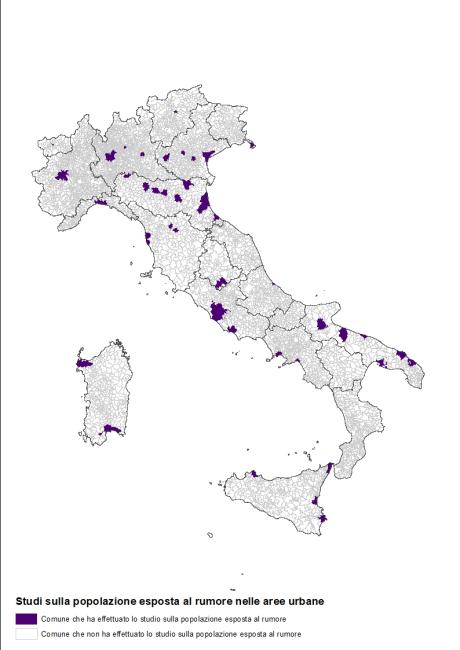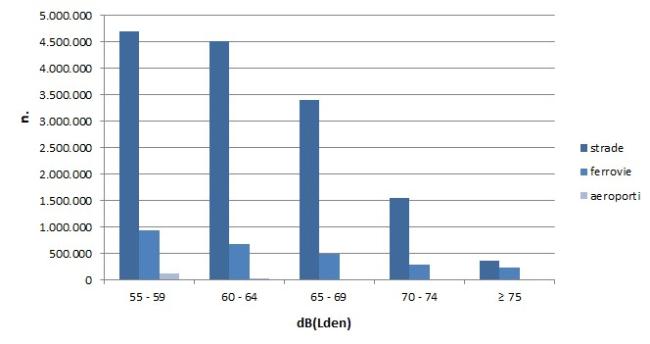Panel 1
Gabriele Bellabarba, Francesca Sacchetti
High noise levels can negatively impact well-being. Health effects of noise include stress, reduced psychological well-being, sleep disturbances, and cardiovascular issues.
With the enactment of Directive 2002/49/EC, the European Union established a common approach to preventing or reducing harmful effects of population exposure to environmental noise. This approach is based on determining environmental noise exposure, informing the public, and implementing local Action Plans. Noise-exposed populations are identified through acoustic mapping, based on common and standardized methodologies.
Acoustic mapping studies indicate that a significant portion of the population is exposed to noise levels exceeding World Health Organization (WHO) recommendations. Road traffic is the primary noise source.
The indicator reports studies conducted in urban areas on noise-exposed populations, developed according to Directive 2002/49/EC, transposed in Italy through Legislative Decree 194/2005. For each study, it presents the estimated number of people exposed to noise, using Lden and Lnight indicators, from different sources (roads, railways, airports, and industries).
Additionally, studies on populations exposed to airport noise are included. The indicator also provides aggregate data on populations exposed to noise from road, rail, and air traffic, based on the 2017 acoustic mapping of transport infrastructure and strategic acoustic mapping of urban agglomerations, in compliance with Directive 2002/49/EC and Legislative Decree 194/2005.
To assess the level of population exposure to noise and identify the most impactful noise sources.
Italy transposed Directive 2002/49/EC (END Directive) on the determination and management of environmental noise through Legislative Decree 194/2005. The directive establishes responsibilities and procedures for preparing acoustic maps of transport infrastructure and strategic noise maps of urban areas, serving as diagnostic tools for assessing noise exposure levels. It also outlines the preparation and adoption of Action Plans aimed at preventing and reducing noise pollution, requiring public information and participation when noise levels may pose health risks.
A key objective of the END Directive is the collection of noise exposure data using standardized methods and criteria, ensuring comparability across time and regions. It sets deadlines and criteria for the submission of acoustic maps and Action Plans, and introduces Lden and Lnight noise descriptors.
The directive required the submission of strategic noise maps by: June 30, 2007: for urban areas with over 250,000 inhabitants, major road networks (>6 million vehicles/year), major railways (>60,000 trains/year), and major airports (>50,000 movements/year) and June 30, 2012, and every five years thereafter: for urban areas with over 100,000 inhabitants, principal road networks (>3 million vehicles/year), principal railways (>30,000 trains/year), and major airports. The Italian Ministry of Environment collects national data and is responsible for communicating information to the European Commission.
The WHO recommends outdoor noise reference values to prevent population disturbance and potential health impacts. Specifically, in the “Night Noise Guidelines (NNG),” the WHO advises maintaining Lnight levels below 40 dB(A) for public health protection and ensuring they do not exceed 55 dB(A).
Panel 2
World Health Organization (WHO), 2018, Environmental Noise Guidelines for the European Region
MATTM, aggiornamento al 2017, Linee Guida “Definizione del contenuto minimo delle relazioni inerenti alla metodologia di determinazione delle mappe acustiche e valori descrittivi delle zone soggette ai livelli di rumore”
MATTM, aggiornamento al 2017, Specifiche tecniche “Predisposizione e consegna della documentazione digitale relativa alle mappature acustiche e mappe acustiche strategiche (D.Lgs. n. 194/2005)”
CEDR, 2013, Best practice in strategic noise mapping
UNI/TS 11387:2010, Linee guida alla mappatura acustica e alla mappatura acustica strategica
World Health Organization (WHO), 2009, Night Noise Guidelines for Europe WG-AEN, 2007, Good Practice Guide for Strategic Noise Mapping and the Production of Associated Data on Noise Exposure
--
--
Data quality assessment
ARPA/APPA (Agenzie Regionali e delle Province Autonome per la Protezione dell'Ambiente) EIONET
The data used for the development of the indicator are derived from the information collected within the Noise Observatory, which can be populated by designated ARPA/APPA representatives and is also publicly accessible at: https://agentifisici.isprambiente.it/osservatoriorumore_public/home.php, as well as from the publicly accessible EIONET website at: http://cdr.eionet.europa.eu/it/eu/noise.
Nazionale, Agglomerati (40/40)
2007-2021
Indicator assessment
The indicator is derived from acoustic mapping data, using methodologies outlined in Directive 2002/49/EC.
Road traffic is the primary noise source, with significant portions of the population exposed to Lden > 65 dB(A) and Lnight > 55 dB(A). Approximately 58% of the population exposed to Lnight levels exceeding 50 dB(A) are subject to noise above WHO’s recommended limit of 55 dB(A) (Table 1).
Aggregated data on population exposure to noise from transport infrastructure indicate that a significant proportion of the Italian population is exposed (Table 3, Figures 2 and 3). The main source of noise is road traffic. Specifically, about 58% of the population exposed to Lnight levels above 50 dB(A) is subjected to levels exceeding the WHO-recommended threshold for public health protection (Lnight = 55 dB(A)) (Figure 3).
Studies on population exposure in agglomerations show a slight decrease over time in the population exposed to the highest noise levels. More robust trend assessments will be conducted once more comprehensive historical data series become available.
Data
Table 1: Studies on the Population Exposed in Urban Areas
ARPA/APPA, EIONET
Table 3: Population Exposed to Transport Noise, by Noise Intervals and Mode of Transport (Directive 2002/49/EC)
ISPRA elaboration based on EIONET data




As shown in Table 1, road traffic is the predominant source of noise, with significant percentages of the population exposed to levels exceeding 65 dB(A) Lden and 55 dB(A) Lnight. In agglomerations where data from two or more noise mapping cycles are available, a slight decrease over time in the population exposed to the highest noise levels has been observed.
Table 2 presents studies on the population exposed to airport noise, conducted between 2006 and 2017, which indicate a decrease in the population exposed to the highest noise levels at some major airports.
The values reported in Table 3, aggregated at the national level, refer to the population exposed to noise from major road, major railway, major airports, and noise generated by roads and railways within agglomerations.
This indicator, positioned within the framework of the Seventh Environment Action Programme (7th EAP) of the European Union - Priority Objective 3b, is useful for monitoring noise pollution by assessing population exposure levels recommended by the WHO. Available data indicate that a high percentage of the population is exposed to noise levels exceeding WHO recommendations. Specifically, about 58% of the population exposed to Lnight levels above 50 dB(A) is subjected to levels exceeding the WHO threshold for public health protection (Lnight = 55 dB(A)) (Figure 3).